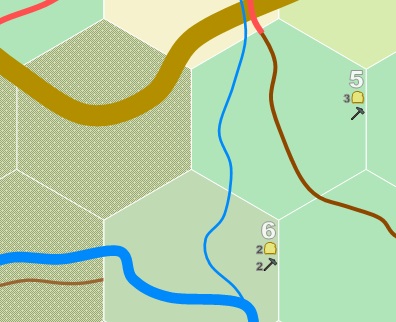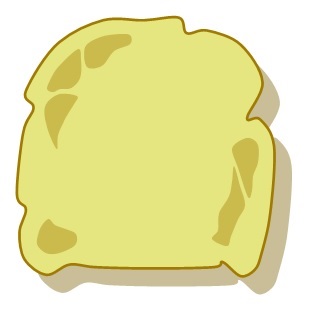Bread (symbol)
-
 6-mile map of a type-5 hex with 3 bread, a type-6 hex with 2 bread, and a type-8 (shape only) which is assumed to have 1 bread (not shown).
6-mile map of a type-5 hex with 3 bread, a type-6 hex with 2 bread, and a type-8 (shape only) which is assumed to have 1 bread (not shown).
Bread is a symbol used on game maps to represent the level of food production available within a given hex, serving as a measure of the world's ability to sustain its population. The quantity of bread assigned to a hex is determined by the hex type, which itself is a function of the region's infrastructure.
Hex types are classified on a scale from 1 to 8, with type-1 hexes representing the most highly civilised and agriculturally developed areas, while type-8 hexes indicate uncivilised wilderness with minimal food production. Consequently, type-1 and type-2 hexes yield the greatest amount of bread, reflecting extensive farming and organised food distribution, whereas type-7 and type-8 hexes provide only scarce resources, requiring inhabitants to rely on hunting, foraging or external supply.
| Hex Type % |
Bread Gained | |
|---|---|---|
| Rural | with Settlement | |
| 8 | 1 | – |
| 7 | 2 | 3 |
| 6 | 2 | 3 |
| 5 | 3 | 4 |
| 4 | 3 | 4 |
| 3 | 3 | 4 |
| 2 | 4 | 5 |
| 1 | 5 | 6 |
Bread Location
Bread is produced in cultivated or arable hexes, which consist primarily of farmland or pastureland. Unlike coins or hammers, bread production is more rigidly fixed, reflecting the structured nature of agriculture and food supply. Bread symbols represent surplus food—resources exceeding the needs of local residents. This means that while a type-6 hex produces more total food than a type-7 hex, it also has a larger population consuming that food, resulting in an equivalent surplus.
Hex types 1 through 7 are classified as "cultivated" hexes, actively contributing to food production. Some type-8 hexes are considered "arable" but remain uncleared, particularly in temperate climates, when adjacent to cultivated hexes, or when they possess sufficient water sources. These hexes supply food through foraging and hunting, allowing them to add to the overall surplus, even if they lack formal agriculture.
Hexes designated as "mined" (see hammer location) are not considered arable. While some food may exist within these hexes, it is only enough for basic subsistence and does not contribute to the larger food surplus.
Methods of Production
Agricultural output occurs in part to the quality of soil and the farming practices that are employed. It's assumed that a type-4 hex has a better soil than a type-5, as the former's presence indicates, through the infrastruction assignment method, that it's clearly more suitable for a larger population. Nonetheless, part of the benefit derived from the soil is accomplished through organisation of labour and mastering the existing conditions more efficiently. The table below therefore provides a general account of what sort of practice is performed according to the bread number and the hex-type.
| # Bread | When Occurring in this Type | |||||||
|---|---|---|---|---|---|---|---|---|
| Type-8 | Type-7 | Type-6 | Type-5 | Type-4 | Type-3 | Type-2 | Type-1 | |
| 1 | hinterland | 2 bread minimum | 3 bread minimum | 4 bread minimum | 5 bread minimum | |||
| 2 | 1 bread maximum | land clearance, open-field farming | ||||||
| 3 | crop rotation | irrigation, surveying | strip farming | livestock farming | mixed farming | |||
| 4 | 3 bread maximum | land tenure | estate management, game reserve | terracing | ||||
| 5 | 4 bread maximum | market gardening | specialised crops | |||||
| 6 | 5 bread maximum | labour-intensive agriculture | ||||||
The table should be read so that a given hex type and number of bread would include everything to the left and above that entry. For example, a type-5 hex with 3 bread would not only include land tenure, but also strip farming and all those practices listed under type-8, type-7 and type-6 ... though progressively, the amount of hinterland in a hex diminishes as the hex-type improves, until a type-1 hex has no hinterland at all.
Physical Production
Surplus agriculture production can be rated according to the number of persons that a bread symbol can feed for a year, presuming an intake of approximately 2600 to 3400 calories. When calculating, count the bread number represents a power of 2 minus 1; thus, 1 bread is 21-1 = "1"; 2 bread = 22-1 = "3", 3 bread = 23-1 = "7" and so on. The series runs, therefore, 1, 3, 7, 15, 31, 63. That number is then multiplied by 70 to give the number of persons the surplus from that hex would produce.
On the map above, the type-8 hex would support 70 additional persons to those within the hex; the type-6 would support 210 and the type-5 would support 490.
See also,
Coin (symbol)
Hammer (symbol)
The Adventure
